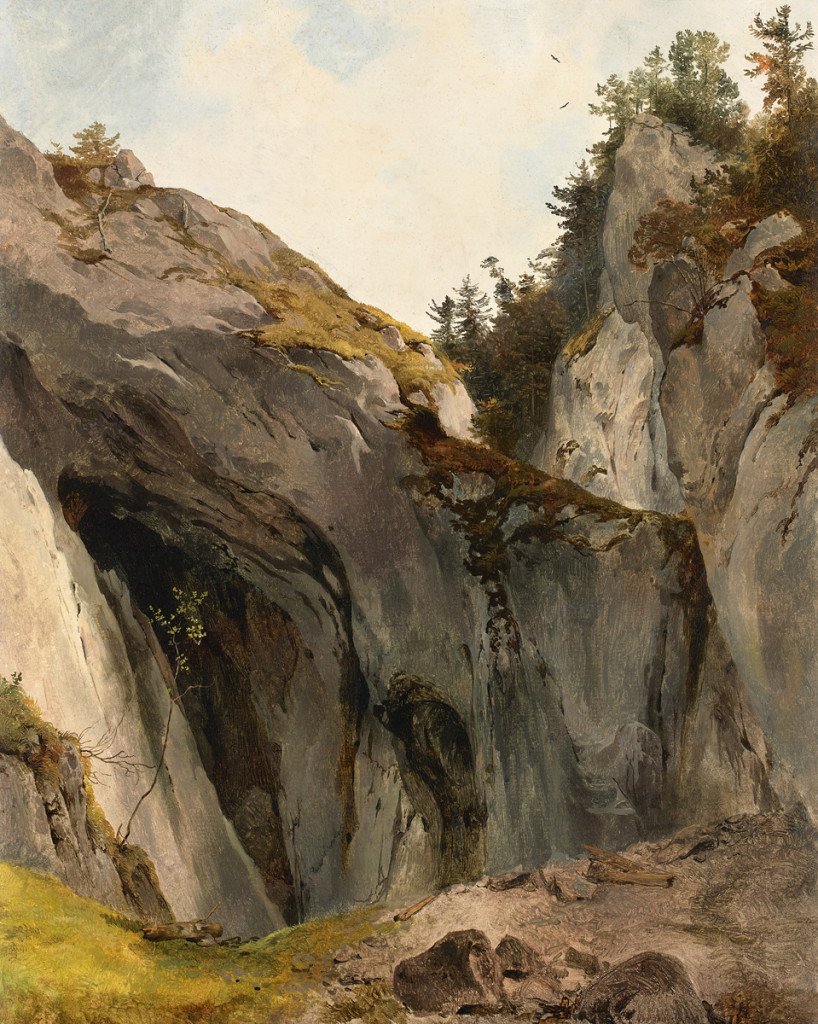Friedrich Gauermann
(Miesenbach, Vienna 1807 - 1862 Vienna)
A Rocky Outcrop with Vegetation. A Nature Study, early 1830s
Oil on paper, 39.9 x 31.7 cm
Provenance (as described by previous owner):
The Klinckowström family, Schloss Stafsund, Sweden;
Klinckowström estate sale, Sweden, 1970s.
We would like to thank Dr.Wolfgang Krug, St. Pölten, for confirming the attribution.
Even though the present work displays extraordinary attention to detail it is without doubt a study executed before nature. The spontaneity of the artist’s observation of his motif is highly appealing. The rock surfaces are executed in rapid, transparent brushstrokes, the vegetation in meticulous, opaque tones.1 The masterly quality bears comparison with the work of no less a figure than Ferdinand Georg Waldmüller, another leading Austrian landscapist. The two artists are known to have worked frequently together en plein-air in the 1830s. They are also known to have held each other’s work in high esteem. The present study is dateable to this period. Particularly in the artist’s lyrical handling of the foliage it recalls the Romantic perception of nature characteristic of the Nazarenes. Gauermann would certainly have been familiar with their work since two members of the group, the brothers Ferdinand and Friedrich Olivier, had spent time in Vienna.
Many of the subjects that Gauermann chose for his studies were motifs that could be used later in the studio as preparatory material. Rocky outcrops and rock faces figure frequently, their erect, stage-like format serving as an ideal backdrop for the images of animals so characteristic of his oeuvre. Nonetheless, in his nature studies he never strayed from the portrayal of the special qualities of a landscape.
It is largely due to the modernity of Gauermann’s nature studies that public interest in his previously somewhat neglected oeuvre has been on the increase since the 1950s. Sabine Grabner, a curator at the Österreichische Galerie Belvedere in Vienna, writes: The artist’s ductus in the preparatory studies – which are marked by highly spontaneous portrayal of detail – is far more striking than in the finished paintings. All of these studies were executed before nature, whether in the area where he spent his childhood, or on hikes in the Salzkammergut.[…].2
It should be emphasized that this study is in an unusually good state of preservation. Almost all Gauermann’s known studies – including those from his estate – were at some point laid down on a support (canvas or cardboard) and cleaned, varnished and where thought necessary, retouched. This work was for the most part carried out in the nineteenth century or perhaps the early twentieth century. It follows that it rarely reached modern professional standards and often led to deterioration, or inflicted unintended damage. Luckily however, the present study escaped these procedures.
Gauermann grew up in Miesenbach, a village south-west of Vienna near the Schneeberg, a popular tourist destination in Lower Austria. As a boy he was taught by his father, the painter Jakob Gauermann, to paint and sketch local landscapes and views. He trained at the Vienna Academy under the Baroque traditionalist Josef Mößmer in 1824-7. In his early career he joined Franz Steinfeld, Friedrich Loos and Ferdinand Georg Waldmüller as a member of the first generation of artists to pioneer a realistic style of landscape painting. As a student he travelled frequently to the Salzkammergut and visited Berchtesgaden and the Königsee. This area of outstanding natural beauty had been discovered a number of years earlier by the Romantic painters – in particular the Dessau-born brothers Ferdinand Olivier (1785-1841) and Friedrich Olivier (1791-1859). Since their discovery of the area, a veritable procession of painters sought to exploit the area as a source of inspiration. Here Gauermann developed, as did Steinfeld and Loos, an entirely new, ‘de-mystified’ response to landscape which he was to apply in his response to the landscapes of his native countryside. The compositional simplicity of his imagery, portraying landscape in the normal light of day with no need for staged effects, reveals a degree of purity in his perception of nature that is unmatched in his later work. The introduction of narrative content to his landscapes was motivated by early observations of nature made in his native countryside. He was also very probably influenced in this direction – as an Academy student – by the paintings of Nicolaes Berchem (1620-83), Paulus Potter (1625-54), Jacob van Ruisdael (1628/29-82) and Philips Wouwermans (1619-68) in the Imperial Collections at the Oberes Belvedere and in private Viennese collections. Initially an embellishment of secondary importance, these narrative elements were increasingly to dominate the image. While motifs of animals fighting and scenes from country life were his preferred subjects, the direct observation of nature was always his first point of departure.3
Other studies by Gauermann comparable to the present study are held at the Österreichische Galerie Belvedere in Vienna, the Niederösterreichisches Landesmuseum in St. Pölten and the Kupferstichkabinett der Akademie der Bildenden Künste in Vienna.4
1 See Rupert Feuchtmüller, Friedrich Gauermann. 1807-1862. Der Tier- und Landschaftsmaler des österreichischen Biedermeier, Vienna 1962, pp. 148, 206 and 216.
2 Einprägsamer als in den ausgeführten Gemälden äußerte sich der Künstler aber in den vorbereitenden Studien, die durch eine spontane Schilderung im Detail gekennzeichnet sind. Diese sind durchwegs vor der Natur entstanden, etwa in der Gegend seiner Kindheit, ebenso auf den Wanderschaften durch das Salzkammergut. …Sabine Grabner in Romantik, Klassizismus, Biedermeier. In der Österreichischen Galerie Belvedere, Vienna 1997, p. 96-7.
3 See < http://digital.belvedere.at/emuseum >, Search Gauermann, Landschaft bei Miesenbach (accessed January 22 2013).
4 Wolfgang Krug, Friedrich Gauermann 1807-1862, Vienna 2001, pp. 122, 140, 146; Friedrich Gauermann 1807-1862, Ölskizzen und Zeichnungen, exhib. cat., Vienna, Kupferstichkabinett der Akademie der Bildenden Künste, 8 May - 8 June 1987, pp. 97, 118, 123.

